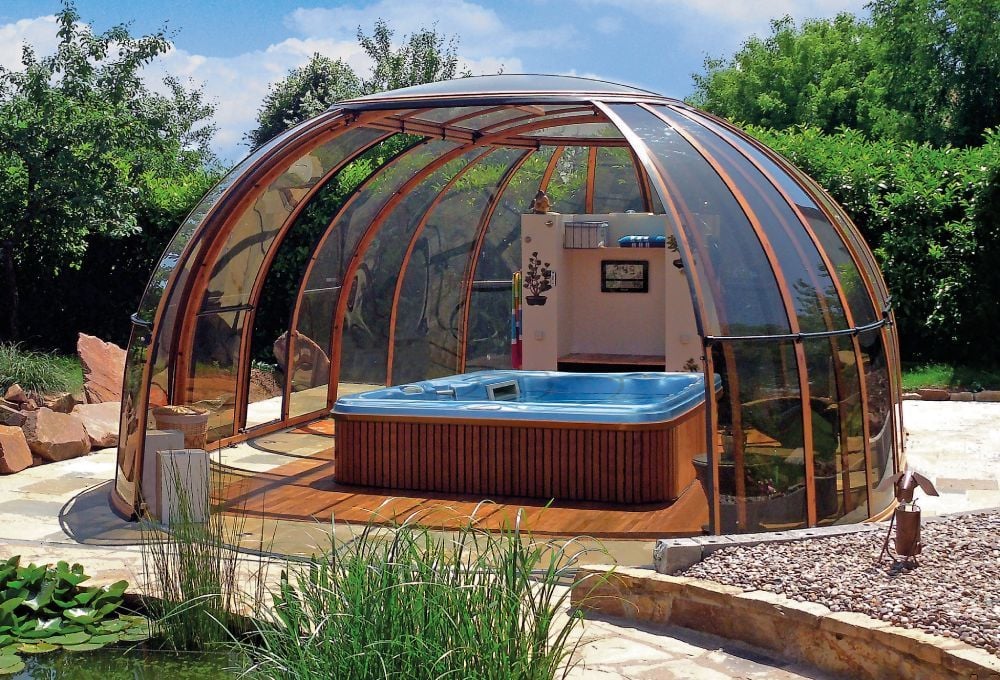Swim Spa Sunroom vs. Traditional Pool: Which is Right for You?

Deciding between a swim spa sunroom and a traditional in-ground pool is a significant choice for homeowners looking to enhance their outdoor living space. Both options offer unique benefits, but they differ in cost, maintenance, functionality, and suitability for various lifestyles. This article compares the two, highlighting the compact size, energy efficiency, and versatility of swim spa sunrooms, particularly for year-round use, to help you determine which is the best fit for your home and needs.
Understanding Swim Spa Sunrooms and Traditional Pools
A swim spa is a compact, self-contained unit that combines the features of a pool and a hot tub. It typically ranges from 10 to 20 feet in length and uses powerful jets to create a current for swimming or resistance exercise. When housed in a sunroom—a glass-enclosed structure with climate control—it becomes a year-round wellness and recreation hub. Swim spa sunrooms are ideal for smaller spaces and offer a spa-like experience with minimal footprint.
A traditional in-ground pool is a larger, permanent installation, often 20 to 40 feet long, designed for swimming, recreation, and aesthetics. These pools are typically open to the elements, though some homeowners add pool covers or enclosures for extended use. Traditional pools are a classic choice for larger properties but come with different considerations for cost and upkeep.
Read more: Top Wheelchair Power Assist Options For Caregivers: Features And Benefits
Cost Comparison: Upfront and Long-Term
Swim Spa Sunroom Costs
The initial cost of a swim spa sunroom varies depending on the size, features, and sunroom construction. A basic swim spa can range from $10,000 to $20,000, while high-end models with advanced jets, heating, and customization can cost $30,000 or more. The sunroom enclosure adds $15,000 to $50,000, depending on materials (e.g., glass, aluminum, or wood) and size. Total upfront costs typically fall between $25,000 and $80,000.
Long-term costs for a swim spa sunroom are relatively low. Swim spas use less water (1,000–2,000 gallons) than traditional pools, reducing water and chemical expenses. Energy-efficient pumps and heaters, combined with insulated sunroom designs, keep utility bills manageable, often $50–$150 per month for heating and operation. Maintenance costs, including filters and chemicals, average $500–$1,000 annually.
Traditional Pool Costs
Traditional in-ground pools have higher upfront costs, typically ranging from $30,000 to $100,000, depending on size, materials (e.g., concrete, fiberglass, or vinyl), and features like lighting or waterfalls. Additional landscaping, fencing, or decking can push costs higher. If a pool enclosure is added for year-round use, expect an additional $20,000 to $100,000, rivaling or exceeding swim spa sunroom costs.
Long-term, traditional pools are more expensive to maintain. They hold 15,000–30,000 gallons of water, requiring more chemicals and frequent cleaning, costing $1,000–$2,500 annually. Energy costs for heating and filtration can range from $100–$300 per month, especially in colder climates. Seasonal opening and closing services add $500–$1,000 per year in some regions.
Verdict: Swim spa sunrooms generally have lower upfront and ongoing costs, making them a more budget-friendly option for many homeowners.
Read more: Living Like Royalty: Top Amenities in High-end Senior Residences for 2025
Maintenance: Time and Effort
Swim Spa Sunroom Maintenance
Swim spas are designed for low maintenance. Their smaller water volume means less chemical balancing, and built-in filtration systems simplify water care. Routine tasks include checking pH levels weekly, cleaning filters monthly, and draining/refilling every 3–6 months, which takes a few hours. The sunroom requires occasional cleaning of glass panels and inspection of seals or vents, but modern materials like powder-coated aluminum resist corrosion and wear.
The controlled environment of a sunroom reduces debris (e.g., leaves, insects) entering the swim spa, minimizing cleaning time. Total maintenance effort is typically 1–2 hours per month, appealing to busy homeowners.
Traditional Pool Maintenance
Traditional pools demand more time and effort. Weekly tasks include skimming debris, vacuuming, and balancing chemicals, which can take 2–4 hours depending on pool size. Filters require backwashing or cleaning monthly, and the pool may need professional servicing for issues like algae or pump failures. In colder climates, winterizing the pool involves draining, covering, and storing equipment, adding time and cost.
Open-air pools are prone to collecting debris, requiring frequent skimming and cleaning. Even with an enclosure, maintenance remains higher than a swim spa due to the larger water volume and surface area. Annual maintenance time can exceed 50 hours for diligent owners.
Verdict: Swim spa sunrooms require significantly less maintenance, saving time and reducing the need for professional services.
Benefits and Versatility
Swim Spa Sunroom Benefits
Swim spa sunrooms shine in their versatility and compact design:
-
Year-Round Use: The sunroom’s climate control allows swimming, hydrotherapy, or relaxation in any weather, from snowy winters to rainy springs.
-
Space Efficiency: Swim spas fit in small backyards, patios, or even indoors, making them ideal for urban homes or properties with limited space.
-
Multifunctionality: Swim spas support swimming against a current, water aerobics, hydrotherapy, and lounging. Adjustable jets and temperatures cater to fitness, relaxation, or rehabilitation.
-
Energy Efficiency: Smaller water volumes and insulated sunrooms reduce heating costs. Some models include energy-saving modes or solar-compatible designs.
-
Privacy and Aesthetics: The sunroom creates a private, spa-like retreat with customizable decor, lighting, and views, enhancing the home’s ambiance.
Swim spa sunrooms are perfect for homeowners seeking a wellness-focused, low-maintenance solution that maximizes small spaces.
Traditional Pool Benefits
Traditional pools offer distinct advantages for specific needs:
-
Recreational Space: Larger pools accommodate group activities, diving, or games like volleyball, making them ideal for families or frequent entertainers.
-
Aesthetic Appeal: A well-designed pool enhances a property’s visual appeal, serving as a centerpiece for landscaping and outdoor living.
-
Swimming Experience: Traditional pools provide a full-length swimming experience without the resistance of a current, appealing to competitive swimmers.
However, traditional pools are less versatile. They’re primarily designed for swimming and lack the hydrotherapy or exercise features of swim spas. Open-air pools are seasonal in many climates unless paired with a costly enclosure, and their larger size requires ample yard space.
Verdict: Swim spa sunrooms offer greater versatility and year-round functionality, while traditional pools excel for recreational group activities and aesthetic impact.
Lifestyle and Space Considerations
Your lifestyle and property size play a crucial role in choosing between the two. A swim spa sunroom is ideal if:
-
You have a small or medium-sized yard (e.g., 200–500 square feet available).
-
You value wellness features like hydrotherapy or low-impact exercise.
-
You prefer year-round use without the hassle of seasonal pool covers.
-
You want a low-maintenance, energy-efficient option that fits a busy schedule.
A traditional pool suits you if:
-
You have a large yard (e.g., 1,000+ square feet) to accommodate the pool and surrounding features like decking or fencing.
-
You host large gatherings or have kids who enjoy pool games.
-
You’re willing to invest time and money in maintenance and seasonal care.
-
You prioritize the classic pool aesthetic and swimming experience.
Environmental Impact
Swim spa sunrooms have a smaller environmental footprint. Their lower water and energy consumption align with eco-conscious living. Many models use energy-efficient pumps and can be paired with solar heating systems. The sunroom’s insulation further reduces energy loss.
Traditional pools consume more water and energy due to their size and exposure to the elements. Chemical usage is higher, and runoff can impact local ecosystems if not managed properly. However, eco-friendly pool designs (e.g., saltwater systems) can mitigate some impacts.
Verdict: Swim spa sunrooms are more environmentally friendly, appealing to sustainability-minded homeowners.
Conclusion
Choosing between a swim spa sunroom and a traditional pool depends on your budget, space, and lifestyle. A swim spa sunroom is the better choice if you prioritize affordability, low maintenance, year-round use, and versatility in a compact footprint. It’s perfect for wellness-focused individuals, small families, or urban homeowners seeking a private retreat. A traditional pool is ideal for those with larger properties, bigger budgets, and a desire for recreational swimming or a striking backyard centerpiece.
Before deciding, evaluate your space, consult with local contractors for quotes, and consider long-term costs. Both options enhance your home, but the swim spa sunroom’s efficiency and flexibility make it a compelling choice for modern living.










